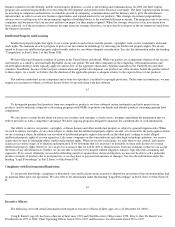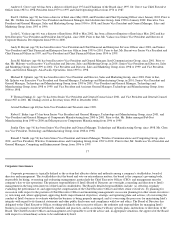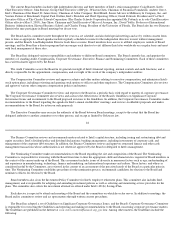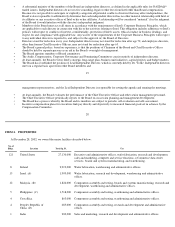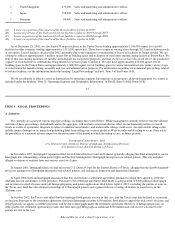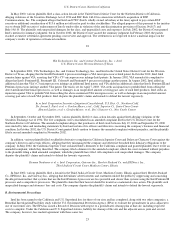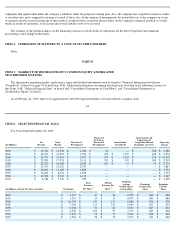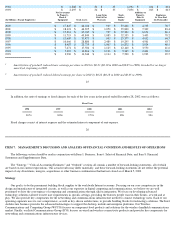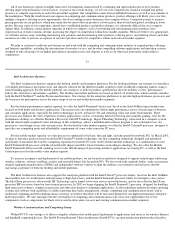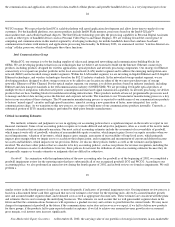Intel 2002 Annual Report Download - page 26
Download and view the complete annual report
Please find page 26 of the 2002 Intel annual report below. You can navigate through the pages in the report by either clicking on the pages listed below, or by using the keyword search tool below to find specific information within the annual report.
equity securities, excluding equity derivatives, totaled $730 million. Our ability to recover our investments in private, non-marketable equity
securities and to earn a return on these investments is primarily dependent on how successfully these companies are able to execute to their
business plans and how well their products are accepted, as well as their ability to obtain venture capital funding to continue operations and to
grow. In the current equity market environment, their ability to obtain additional funding as well as to take advantage of liquidity events, such as
initial public offerings, mergers and private sales, is significantly constrained.
Under our accounting policy, the carrying value of a non-marketable investment is the amount paid for the investment unless it has been
determined to be other than temporarily impaired, in which case we write the investment down to its impaired value. We review all of our
investments periodically for impairment; however, for non-marketable equity securities, the impairment analysis requires significant judgment.
This analysis includes assessment of each investee's financial condition, the business outlook for its products and technology, its projected
results and cash flows, the likelihood of obtaining subsequent rounds of financing and the impact of any relevant contractual equity preferences
held by Intel or others. If an investee obtains additional funding at a valuation lower than our carrying amount, we presume that the investment is
other than temporarily impaired, unless specific facts and circumstances indicate otherwise, for example if we hold contractual rights that give us
a preference over the rights of other investors. As the equity markets have declined significantly over the past two years, we have experienced
substantial impairments in our portfolio of non-marketable equity securities. If equity market conditions do not improve, as companies within
our portfolio attempt to raise additional funds, the funds may not be available to them, or they may receive lower valuations, with more onerous
investment terms than in previous financings, and the investments will likely become impaired. However, we are not able to determine at the
present time which specific investments are likely to be impaired in the future, or the extent or timing of individual impairments. During 2002,
we recorded impairments of non-marketable equity investments of $510 million ($448 million in 2001).
Inventory. Our policy for valuation of inventory, including the determination of obsolete or excess inventory, requires us to estimate the
future demand for our products within specific time horizons, generally six months or less. The estimates of future demand that we use in the
valuation of inventory are the basis for our published revenue forecast, which is also consistent with our short-term manufacturing plan. If our
demand forecast for specific products is greater than actual demand and we fail to reduce manufacturing output accordingly, we could be
required to record additional inventory reserves, which would have a negative impact on our gross margin.
Long-Lived Assets. We assess the impairment of long-lived assets when events or changes in circumstances indicate that the carrying
value of the assets or the asset grouping may not be recoverable. Factors we consider in deciding when to perform an impairment review include
significant under-performance of a business or product line in relation to expectations, significant negative industry or economic trends, and
significant changes or planned changes in our use of the assets. Recoverability of assets that will continue to be used in our operations is
measured by comparing the carrying amount of the asset grouping to the related total future net cash flows. If an asset grouping's carrying value
is not recoverable through those cash flows, the asset grouping is considered to be impaired. The impairment is measured by the difference
between the assets' carrying
30
amount and their fair value, based on the best information available, including market prices or discounted cash flow analysis.
Due to our asset usage model and the fungible nature of our semiconductor manufacturing capacity, we must make subjective judgments in
determining the asset groupings and the related independent cash flows for the asset recoverability test. In addition, as we make manufacturing
process conversions and other factory planning decisions, we must make subjective judgments regarding the remaining useful lives of assets,
primarily process-specific semiconductor manufacturing tools and building improvements. When we determine that the useful lives of assets are
shorter than we had originally estimated, and there are sufficient cash flows to support the carrying value of the assets, we accelerate the rate of
depreciation charges in order to fully depreciate the assets over their new, shorter, useful lives.
Income Taxes. In determining income for financial statement purposes, we must make certain estimates and judgments. These estimates
and judgments occur in the calculation of certain tax liabilities and in the determination of the recoverability of certain of the deferred tax assets,
which arise from temporary differences between the tax and financial statement recognition of revenue and expense.
We must assess the likelihood that we will be able to recover our deferred tax assets. If recovery is not likely, we must increase our
provision for taxes by recording a reserve, in the form of a valuation allowance, for the deferred tax assets that we estimate will not ultimately be
recoverable. As of December 28, 2002, we believe that all of our recorded deferred tax assets will ultimately be recovered. However, should
there be a change in our ability to recover our deferred tax assets, our tax provision would increase in the period in which we determine that the
recovery is not probable.
In addition, the calculation of our tax liabilities involves dealing with uncertainties in the application of complex tax regulations. We
recognize potential liabilities for anticipated tax audit issues in the U.S. and other tax jurisdictions based on our estimate of whether, and the
extent to which, additional taxes will be due. If payment of these amounts ultimately proves to be unnecessary, the reversal of the liabilities
would result in tax benefits being recognized in the period when we determine the liabilities are no longer necessary. If our estimate of tax
liabilities proves to be less than the ultimate assessment, a further charge to expense would result.
Results of Operations


